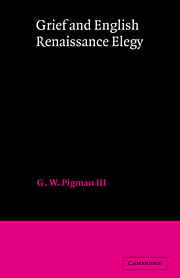Book contents
- Frontmatter
- Contents
- Acknowledgments
- Introduction
- Chapter 1 The Angry Consoler
- Chapter 2 The Emergence of Compassionate Moderation
- Chapter 3 Praise and Mourning
- Chapter 4 The Shift from Anxious Elegy
- Chapter 5 Surrey and Spenser
- Chapter 6 Jonson and King
- Chapter 7 Milton
- Conclusion
- Notes
- Bibliography
- Index
- Frontmatter
- Contents
- Acknowledgments
- Introduction
- Chapter 1 The Angry Consoler
- Chapter 2 The Emergence of Compassionate Moderation
- Chapter 3 Praise and Mourning
- Chapter 4 The Shift from Anxious Elegy
- Chapter 5 Surrey and Spenser
- Chapter 6 Jonson and King
- Chapter 7 Milton
- Conclusion
- Notes
- Bibliography
- Index
Summary
I began the research for this book in an effort to understand two lines in one of the most famous poems in the language:
And O ye Dolphins, waft the hapless youth.
Weep no more, wofull shepherds weep no more….
This leap from plaintive helplessness to authoritative consolation has troubled many readers of ‘Lycidas’. How can the speaker's voice change so abruptly and dramatically? Infusion of grace? Intervention of Michael the archangel? Neither of these solutions seemed persuasive to me, and although I had no explanation to offer, I remained convinced of the unity of ‘Lycidas’. My own groping for an explanation led me to Milton's allusive criticisms and revisions of pastoral elegy, particularly Virgil's Eclogue 10 and Theocritus' Idyll 1. It occurred to me that what gave the poem its unity was Milton's insistence on the inability of pastoral to console for death; Milton was triumphantly opposing Christian consolation to pagan mourning. I was rather pleased with this interpretation – even though it did not explain the shift of voice – until I asked myself what was Christian about consolation, what was pagan about mourning, and what were the attitudes of Milton and his contemporaries to consolation and mourning?
When I began to investigate these questions, my understanding of mourning in Renaissance England was largely restricted to the lines from Twelfth Night which I have prefixed to the second chapter, and to Jonson's ‘Of Death’.
- Type
- Chapter
- Information
- Grief and English Renaissance Elegy , pp. 1 - 10Publisher: Cambridge University PressPrint publication year: 1985



